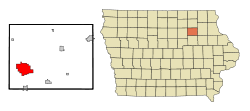Waverly, Iowa
| Waverly, Iowa | |
|---|---|
| City | |

Waverly, Iowa
|
|
 Location of Waverly, Iowa |
|
| Location in the United States | |
| Coordinates: 42°43′36″N 92°28′31″W / 42.72667°N 92.47528°WCoordinates: 42°43′36″N 92°28′31″W / 42.72667°N 92.47528°W | |
| Country |
|
| State |
|
| County | Bremer |
| Area | |
| • Total | 11.51 sq mi (29.81 km2) |
| • Land | 11.01 sq mi (28.52 km2) |
| • Water | 0.50 sq mi (1.29 km2) |
| Elevation | 912 ft (278 m) |
| Population (2010) | |
| • Total | 9,874 |
| • Estimate (2012) | 10,035 |
| • Density | 896.8/sq mi (346.3/km2) |
| Time zone | Central (CST) (UTC-6) |
| • Summer (DST) | CDT (UTC-5) |
| ZIP code | 50677 |
| Area code(s) | 319 |
| FIPS code | 19-82875 |
| GNIS feature ID | 0462757 |
| Website | Waverly, Iowa |
Waverly is a city in Bremer County, Iowa, United States. The population was 9,874 at the 2010 census. It is the county seat of Bremer County and is part of the Waterloo–Cedar Falls Metropolitan Statistical Area.
The sister city of Waverly is the German city of Eisenach, which is famous for the Wartburg castle. Waverly is also the home of Wartburg College which is named after this castle.
The first permanent residents of Waverly were settled there against their will. Because of their alleged assistance given to Chief Black Hawk during the Blackhawk War of 1832, the Winnebago were forced to cede their lands east of the Mississippi and to move to Neutral Ground in what is now northeastern Iowa. They were to receive $270,000 ($10,000 per year for 27 years) and were required to surrender several of their tribesmen accused of murdering whites during the war. At that time there were three tribes living in the area, the Winnebagoes numbering about 500, the Mesquakie numbering about 100 and the Pottawattomies numbering about 50. With Iowa statehood in 1846, the Winnebago were moved again. In an 1845 treaty, the Winnebago exchanged their Iowa lands for the 800,000-acre (3,200 km2) Long Prairie (Crow Wing River) reserve in Minnesota and $190,000. In 1848 a detachment of United States troops from Fort Atkinson, Iowa came to enforce the removal. All told, between 1840 and 1863 the Winnebagoes were moved five times. They were pushed first to northeastern Iowa, then to Long Prairie, Minnesota, then to Blue Earth, Minnesota, then to Crow Creek, South Dakota. In 1865, after the constant upheaval cost 700 tribal members’ lives, the current Winnebago Reservation in Nebraska was established by the treaties of 1865 and 1874. The tribe lost more than two thirds of this land in the General Allotment Act of 1887. By 1913, only 120,000 acres (490 km2) of cropland, woodland, and pasture remained. The tribe is federally recognized and organized under the 1934 Indian Reorganization Act. The Winnebago Tribe established a constitution in 1936 which was amended in 1968.
...
Wikipedia

